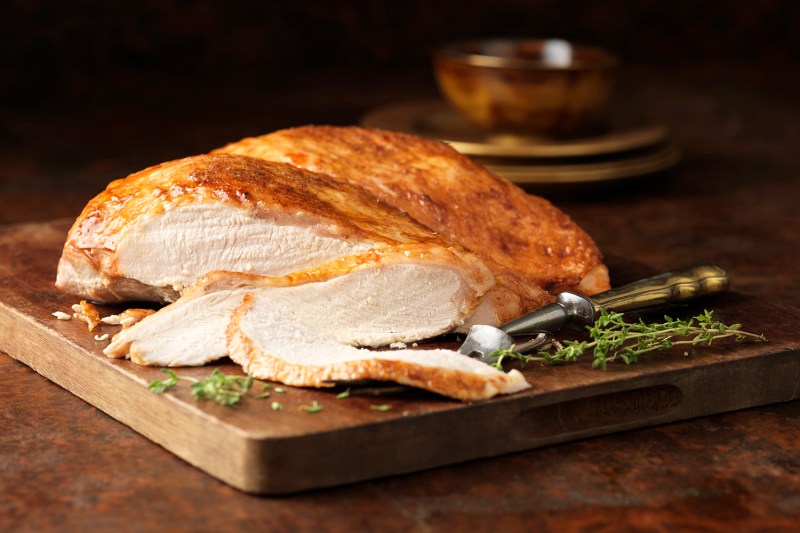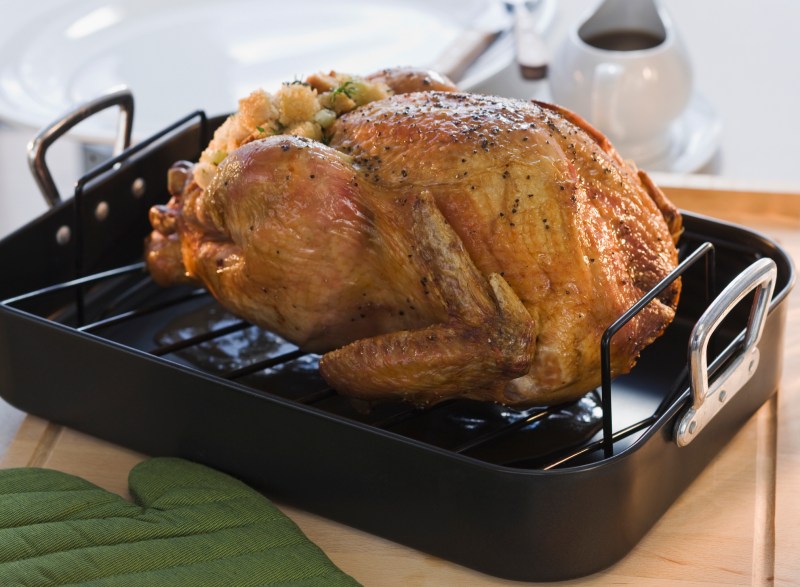If we’re all being honest here, the “turkey” part of Thanksgiving dinner tends to be the least impressive part of the yearly feast. That’s generally because turkey dries out easily and lacks the natural flavor of heartier meats like lamb, pork, and prime rib. So, on a typical Thanksgiving table, the turkey plays second fiddle to more interesting side dishes like mashed potatoes, yams, stuffing, and Brussels sprouts. Are you looking to take your side dishes to the next level? Try these smoked Thanksgiving sides.
However, enterprising cooks are always seeking ways to elevate the Thanksgiving turkey and turn it into a dish worth craving. For pro chefs, a tried-and-true solution to the flavorless turkey problem is “brining,” a pre-roasting process designed to seal in moisture and add touches of spices, herbs, and other seasonings.
In the simplest terms, brining a turkey involves coating it with salt (either using a “wet” bath of salt and liquid or a “dry” rub of salts and spices) and allowing it to rest and fully absorb both the flavor and the moisture-saving properties of the salt. What ingredients to include in your brine is totally up to you. Play with different wet and dry ingredients to achieve a flavor blend that suits your tastes. If you want to try brining your bird this year, here are some tips from professional chefs on how to brine turkey.
Tips for brining your Thanksgiving turkey

Don’t be afraid to customize your brine with herbs, spices, and alternative liquids
As we mentioned previously, brining offers plenty of space for experimentation and exciting flavor combinations. When it comes to wet brines, chef (and Top Chef alum) Chris Scott of the Institute of Culinary Education said that “the essentials for [wet] brining are salt and water. Whatever else you add to it is up to the chef’s discretion for flavoring. After making your brine, you can heat it to infuse all those flavors. Make sure you cool it completely before pouring it over raw poultry so it doesn’t cook it. Through osmosis, the flavors infuse into the bird.”
Chef Joshua Smith, formerly of The Four Seasons Boston, also likes to put his own stamp on a classic liquid brine; he said his preferred method is “brining turkeys in buttermilk, fresh thyme, crushed garlic, and freshly cracked white pepper. We let this sit for at least 24 hours, and [the brine] yields great results. The great thing [about using buttermilk] is that the lactic acid starts to break down the muscle structure [of the turkey] while adding flavor and drawing out any blood. With 3% to 4% lactic acid, buttermilk also acts as an antimicrobial on any potential pathogens that may be present.”
There are benefits to both “wet” and “dry” brine styles
Wet brining requires a long soak, and dry brining requires a thorough rub on the outside of the turkey. Both versions will yield a tender and juicy bird. Chef Chris Carter of Porter Road in Nashville, Tennessee, said, “Choosing a wet versus a dry brine is a personal preference. Both styles of brining add incredible flavor to the turkey through the combination of salt and any other seasonings you choose to add, which penetrate into the meat over several hours (or, ideally, overnight). Wet brining allows the turkey to absorb additional moisture, whereas dry brining dries out the skin, so it can become deliciously crisp during the cooking process.”
Take your time with the brining process
Brine aficionados emphasize the importance of allowing your turkey to hang out in the brine (whether wet or dry) for a significant time to reap all of the positive results. Chef John Lechleidner, formally of WP24 by Wolfgang Puck in Los Angeles and now the owner of Spoon Spices, embraces the “slow burn” brine technique.
“First, you need to brine for 24 to 36 hours,” he said. “When I make my brine, I keep it simple with just salt, water, sugar, peppercorn, garlic, onion, and celery. Once your turkey is brined, let it sit in the fridge for 24 hours, uncovered, so the skin dries out. Before you cook your turkey, let it sit out for about three hours on the counter uncovered to help do a final push to dry the skin. You can roast your turkey covered for about an hour, then finish roasting uncovered. This should give you a moist and crispy turkey skin. Let the turkey rest for 30 to 40 minutes before carving the turkey. While it is resting, you can make your pan gravy and have it ready at the same time.”
A slow roast followed by a heat “blast” leads to juicy meat and crispy skin
Chef Eli Collins of a. kitchen and a. bar in Philadelphia likes to add roasting-temp variety to highlight the flavors imparted by a brine. He said to “roast [the brined turkey] at a low temperature and take it out when it’s about three-quarters of the way done. Let it sit for an hour, then blast it with high heat. The crispiness of the skin comes from drying it [post-brine], then cooking it at a low enough temperature so the skin renders. Blasting it is almost like air-searing it; the turkey emerges juicy with savory, crispy skin.”
Try these brine recipes

If you’d like to give turkey-brining a shot this year, we have a couple of unique brine recipes well worth trying:
Ceylon and herb turkey brine recipe
This recipe was created by Heather Pelletier, Executive Chef of Chumley’s in New York City. Chumley’s is now closed, but the recipe lives on.
Ingredients:
- 6 quarts water
- 1 1/2 cups salt
- 1 to 3 bags of Ceylon tea
- 2 heads garlic
- 1 bay leaf
- Peels and juice of several lemons and oranges, to taste
- Rosemary, to taste
- Thyme, to taste
- Sage, to taste
- Black pepper, to taste
- Coriander, to taste
Method:
- Place all ingredients in a pot with 3 quarts of water and bring to a boil.
- Turn off the heat and add 3 quarts of freezing-cold water (half of this could even be ice) to quickly cool the boiling water.
- Once the water is VERY cold, add the turkey and put it in the fridge for 24 hours.
- Remove the turkey and pat the skin dry. Put it back in the fridge for 24 hours to continue to dry out.
Chef Heather Pelletier of Chumley’s, a historic New York City pub where F. Scott and Zelda Fitzgerald were once regulars, said that she likes to infuse her turkey brine with Ceylon tea, appreciating the citrus notes that the tea adds.
Sweet, spicy, and sour whiskey brine recipe
Created by Will Harris, Executive Chef, Whole Harvest, Denver
Ingredients:
- 3 cups salt (Harris recommends kosher salt, but said sea salt can also be used, with a reduction to 2 cups)
- 1 cup cane or brown sugar
- 1 large onion, roughly chopped
- 1 whole bulb of garlic, sliced in half (no need to peel it)
- 3 whole limes, sliced and squeezed
- 2 whole oranges, sliced and squeezed
- 2 tablespoons whole peppercorns
- 4 cinnamon sticks
- 2 tablespoons coriander seeds
- 2 tablespoons mustard seeds
- 3 to 4 jalapeños, sliced, seeds and all
- 6 lime leaves (if you can’t find these, use bay leaves)
- 1 cup maple syrup or agave
- 2 cups whiskey of your choice
- 2 1/2 gallons of water
Method:
- Add water and salt to a pot and bring to a boil.
- Add the rest of the ingredients, turn off the heat, and cover. Let sit for two to three hours for flavors to develop.
- Once the brine is cool, add your meat and refrigerate overnight or for up to three days. Remove meat and let air dry before cooking.
When it comes to a proper Thanksgiving turkey dinner, whiskey can do more than just get you properly sauced for the football games on TV. According to Chef Will Harris of Whole Harvest in Denver, it can also serve as a crucial ingredient to a bold and lively turkey brine. “The key to a brine is a balance of acid, salt, and sweetness,” he said. “Everything else is for extra flavor and surprising elements. This brine can be used for chicken, duck, pheasant, pork … and, of course, turkey. The whiskey will give the [meat] a rich and supple balance. This is a great way to add complex flavors to your roast of choice.”
Once your turkey is cooked, next is learning how to carve a turkey to ensure your bird tastes great and looks great, too.
How to dry brine a turkey

Our last two recipes are great examples of the wet brining method for turkey, but astute readers will remember that we said that two methods could be used to brine a turkey: wet and dry. As the name suggests, a dry brine involves no liquid at all, at least at the start. As the turkey brines, the salt will draw out the turkey’s juices to form a sort of natural brine. Then, that liquid is absorbed into the meat, leading to a tender and juicy turkey with a deliciously crispy skin.
Dry brine for turkey
(Recipe from Epicurious)
Ingredients:
- 1 turkey, thoroughly thawed
- 1 tablespoon of kosher salt for every 5 pounds of turkey
- 1 teaspoon white or brown sugar
- Freshly ground black pepper, to taste
- Dried herbs such as rosemary, thyme, sage, celery seeds, etc., or whatever herbs you prefer
Method:
- Mix the salt, sugar, pepper, and herbs in a small bowl.
- Remove any packaging from the turkey and remove the neck and giblets (these can be discarded or used for gravy).
- Pat the outside of the turkey dry with a paper towel.
- Place the turkey breast-side up in a roasting pan with a rack (you can also use a rimmed baking sheet with a cooling rack).
- Loosen the skin of the breast and legs with your fingers.
- Sprinkle the inside and outside of the turkey with the brine, putting most of the salt on the breasts.
- Refrigerate uncovered for 12-72 hours to allow the skin to dry.
- When you’re ready to cook, remove the turkey from the refrigerator, pat it dry (do not rinse the turkey), rub the skin with oil, and roast according to the instructions.



